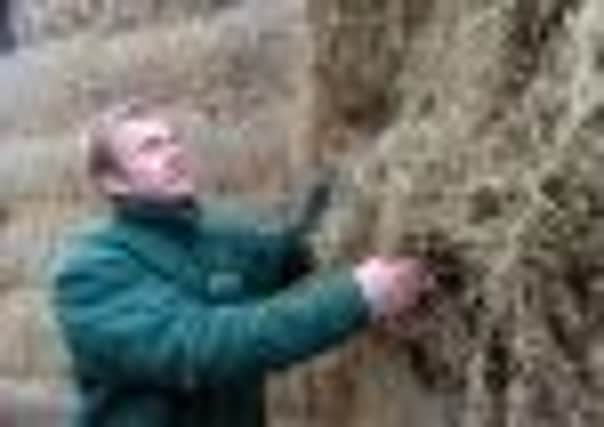Farm Of The Week: Making hay whatever the weather


If there is anything in those generalisms, Smithy Briggs Farm is a good example.
It is hard to know where to start explaining its interlocking interests, so the beginning will have to do.
Advertisement
Hide AdAdvertisement
Hide AdPeter Caley’s great-grandad started his family’s tenancy of the 120-acre farm on the Burton Constable estate, near Skirlaugh, where Hull gives way to the flat and fertile lowlands known as Holderness.
When Peter was growing up there, the businesses were arable (wheat, oilseed rape, peas) plus bed-and-breakfast pigs living on the straw from the crops. Both are still important.
But 20 years ago his father, John, got a contract to supply hay to a riding stables. And that led to others.
When Peter returned home to work, after college and five years in consultancy, they needed a way of expanding without more land. And as everywhere, the horse business was booming faster than anything in farming.
Advertisement
Hide AdAdvertisement
Hide AdHorse owners can generally afford to be fussier than farmers looking for livestock feed, especially when the horses are expensive ones. And they want fully ripened hay rather than silage and haylage, the half-wet products which have become the standard way of keeping grass for winter, thanks to plastic for wrapping it in.
Even for farm livestock, however, there are advantages to good old hay, says Peter.
“As soon as you unload it, you know exactly what you are getting.”
Silage/haylage has taken over a lot of the market because hay is trickier. Peter, now 32, and his dad, 52, have built up Smithy Briggs Hay & Straw by learning to get it right.
Advertisement
Hide AdAdvertisement
Hide AdThe farm is the business base but most of the products come from collaborations. Last year, Smithy Briggs brokered 600 acres of grass to about a hundred customers – some as haylage but most as good old-fashioned sweet hay – and 2,000 acres of straw.
You can get hay through the small ads for £50-£100 a tonne. But hay is a loose definition.
Smithy Briggs prices vary according to size of order, delivery costs, etcetera, but Peter says they aim for £120-£130 for a tonne leaving their gate in large bales. For that, he guarantees “good clean hay” – not certificated, but free of mould, as free of dust as it can be and your money back if not satisfied.
To meet a range of nutritional needs, from rabbits through stud bulls to polo ponies, he grows and buys both standard ‘meadow hay’, from permanent pasture – usually improved a bit with fertiliser and aeration – and ‘seed hay’, grown from a mix planted fresh every three years. He uses one recommended by British Seed Houses. His main hay supplier, neighbour and cousin Simon Caley, at West Newton, uses Nickerson’s. But the mixes are similar – some rye grasses, some timothy and, crucially, no clover, because it takes too long to die and dry.
Advertisement
Hide AdAdvertisement
Hide Ad“You tell me what you want it for and we supply the hay best suited,” he sums up. “If you are a regular customer, we try to make sure we have your needs in stock. And we deliver when you want it and how, down to taking it into the stable if that is where you want it. For all that, we can charge a little bit over the basic for any old hay.”
There are knock-on benefits from including grass in a crop rotation, he adds. For various reasons, it means less black-grass in a following wheat crop. One way and another, the returns from hay add up to similar to wheat, he reckons – “and it’s a lot more fulfilling and fun to sell direct to the end user”.
So far, they can handle all their business without artificial drying. But they do use an imported product called Baler’s Choice, a mould inhibitor, which means they can bale with a moisture content of up to 25 per cent, at a cost of up to £12 a tonne, when the weather dictates.
One of their baling machines has been retro-fitted with a tank for the fluid and the kit for measuring moisture content in the crop and injecting as appropriate.
Advertisement
Hide AdAdvertisement
Hide AdThe straw business is similar. Smithy Briggs buys it from all over, stores it and sells it.
Demand from the power stations, who are subsidised to burn it, has put a price on crop waste which used to be free to anyone willing to pick it up from ‘the swath’, incidentally.
All this brings us to the farm’s latest venture.
Six Valley Lamb is a partnership with Adam Palmer, an old mate from student days, based at Thixendale.
This visit was prompted by an announcement that Six Valley Lamb had appointed its own shepherd, Lizzie Jennings of Malton, who recently graduated from Bishop Burton College and will be familiar to Malton Mart regulars as a sales-day assistant. Adam Palmer already had 300 Mule ewes but was too busy with his high-end oil business – yorkshirerapeseedoil.co.uk – to do anything new with them. Peter Caley was interested in sharing them, because one of the keys to good hay is to get last year’s leftovers grazed down tight, and it is not always easy to borrow sheep in Holderness.
Advertisement
Hide AdAdvertisement
Hide AdBetween them, the two farmers have expanded the breeding flock to 550 and are currently window-shopping for sires.
But the most interesting thing about the collaboration, which means ferrying sheep 40 miles, is that the aim is to produce lambs fattened entirely on grass – started alongside their mothers on Wolds dalesides and finished on best East Yorkshire meadow.
Call Peter Caley on 07919 287479 or Adam Palmer on 07904 430619 or email [email protected]/